Wound-healing capabilities of whale sharks (Rhincodon typus) and implications for conservation management
- PMID: 33569175
- PMCID: PMC7859907
- DOI: 10.1093/conphys/coaa120
Wound-healing capabilities of whale sharks (Rhincodon typus) and implications for conservation management
Abstract
Wound healing is important for marine taxa such as elasmobranchs, which can incur a range of natural and anthropogenic wounds throughout their life history. There is evidence that this group shows a high capacity for external wound healing. However, anthropogenic wounds may become more frequent due to increasing commercial and recreational marine activities. Whale sharks are particularly at risk of attaining injuries given their use of surface waters and wildlife tourism interest. There is limited understanding as to how whale sharks recover from injuries, and often insights are confined to singular opportunistic observations. The present study makes use of a unique and valuable photographic data source from two whale shark aggregation sites in the Indian Ocean. Successional injury-healing progression cases were reviewed to investigate the characteristics of injuries and quantify a coarse healing timeframe. Wounds were measured over time using an image standardization method. This work shows that by Day 25 major injury surface area decreased by an average of 56% and the most rapid healing case showed a surface area reduction of 50% in 4 days. All wounds reached a point of 90% surface area closure by Day 35. There were differences in healing rate based on wound type, with lacerations and abrasions taking 50 and 22 days to reach 90% healing, respectively. This study provides baseline information for wound healing in whale sharks and the methods proposed could act as a foundation for future research. Use of a detailed classification system, as presented here, may also assist in ocean scale injury comparisons between research groups and aid reliable descriptive data. Such findings can contribute to discussions regarding appropriate management in aggregation areas with an aim to reduce the likelihood of injuries, such as those resulting from vessel collisions, in these regions or during movements between coastal waters.
Keywords: Healing rate; anthropogenic activities; conservation management; whale shark; wildlife injuries; wound healing.
© The Author(s) 2021. Published by Oxford University Press and the Society for Experimental Biology.
Figures

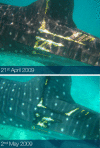
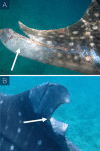


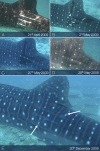
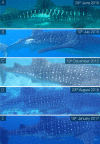


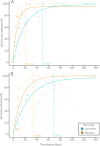
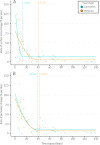
Similar articles
-
The impact of injury on apparent survival of whale sharks (Rhincodon typus) in South Ari Atoll Marine Protected Area, Maldives.Sci Rep. 2021 Jan 13;11(1):937. doi: 10.1038/s41598-020-79101-8. Sci Rep. 2021. PMID: 33441580 Free PMC article.
-
Satellite tagging highlights the importance of productive Mozambican coastal waters to the ecology and conservation of whale sharks.PeerJ. 2018 Jan 2;6:e4161. doi: 10.7717/peerj.4161. eCollection 2018. PeerJ. 2018. PMID: 29312815 Free PMC article.
-
Regional movements of satellite-tagged whale sharks Rhincodon typus in the Gulf of Aden.Ecol Evol. 2021 Mar 23;11(9):4920-4934. doi: 10.1002/ece3.7400. eCollection 2021 May. Ecol Evol. 2021. PMID: 33976859 Free PMC article.
-
Inferred global connectivity of whale shark Rhincodon typus populations.J Fish Biol. 2013 Feb;82(2):367-89. doi: 10.1111/jfb.12017. Epub 2013 Jan 29. J Fish Biol. 2013. PMID: 23398057 Review.
-
A review of the biology, fisheries and conservation of the whale shark Rhincodon typus.J Fish Biol. 2012 Apr;80(5):1019-56. doi: 10.1111/j.1095-8649.2012.03252.x. J Fish Biol. 2012. PMID: 22497372 Review.
Cited by
-
Global collision-risk hotspots of marine traffic and the world's largest fish, the whale shark.Proc Natl Acad Sci U S A. 2022 May 17;119(20):e2117440119. doi: 10.1073/pnas.2117440119. Epub 2022 May 9. Proc Natl Acad Sci U S A. 2022. PMID: 35533277 Free PMC article.
-
Pathological study of a traumatic anthropogenic injury in the skeleton of a spiny butterfly ray (Gymnura altavela).Front Vet Sci. 2024 Oct 24;11:1452659. doi: 10.3389/fvets.2024.1452659. eCollection 2024. Front Vet Sci. 2024. PMID: 39512913 Free PMC article.
-
Case report: Management and long-term ophthalmic sequelae of monogenean ocular infestation in cownose rays (Rhinoptera bonasus).Front Vet Sci. 2024 Jun 19;11:1401141. doi: 10.3389/fvets.2024.1401141. eCollection 2024. Front Vet Sci. 2024. PMID: 38966566 Free PMC article.
-
The salamander blastema within the broader context of metazoan regeneration.Front Cell Dev Biol. 2023 Aug 11;11:1206157. doi: 10.3389/fcell.2023.1206157. eCollection 2023. Front Cell Dev Biol. 2023. PMID: 37635872 Free PMC article. Review.
-
Elasmobranch microbiomes: emerging patterns and implications for host health and ecology.Anim Microbiome. 2021 Sep 15;3(1):61. doi: 10.1186/s42523-021-00121-4. Anim Microbiome. 2021. PMID: 34526135 Free PMC article. Review.
References
-
- Anderson CD, Roberts RJ (1975) A comparison of the effects of temperature on wound healing in a tropical and a temperate teleost. J Fish Biol 7: 173–182.
-
- Aubrey CW, Snelson FF Jr (2007) Early life history of the spinner shark in a Florida nursery In CT McCandless, NE Kohler, HL Pratt Jr, eds, Shark Nursery Grounds of the Gulf of Mexico and the East Coast Waters of the United States. American Fisheries Society, Symposium 50, Bethesda, MD, pp. 175–179.
-
- Bansemer CS, Bennett MB (2010) Retained fishing gear and associated injuries in the east Australian grey nurse sharks (Carcharias taurus): implications for population recovery. Mar Freshwater Res 61: 97–103.
-
- Bates D, Mächler B, Bolker B, Walker S (2014) Fitting linear mixed-effects models using lme4. J Stat Softw 67: 1–48.
LinkOut - more resources
Full Text Sources
Other Literature Sources

